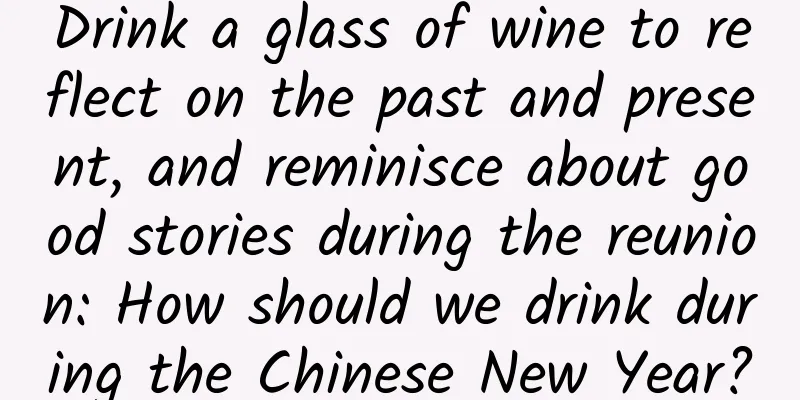Drink a glass of wine to reflect on the past and present, and reminisce about good stories during the reunion: How should we drink during the Chinese New Year?

|
The Spring Festival is the most important traditional festival for Chinese people. Busy people will go home to reunite with their families no matter how far away they are, to welcome the new year and bring good luck. As the saying goes, "no wine, no ceremony", when friends and relatives get together, it is inevitable to have a drink or drink. For Chinese people, wine is not only a drink, but also a symbol of Chinese civilization. The customs related to drinking are deeply engraved in the blood of Chinese people . Copyright images in the gallery. Reprinting and using them may lead to copyright disputes. 01 It is not just wine, but also a thousand-year-old Chinese culture From ancient times to the present, wine seems to run through history and civilization. Among the bronze vessels excavated from the Xia, Shang and Zhou dynasties, a large number of wine vessels and pottery were unearthed. At that time, drinking vessels made of bronze were classified as ritual vessels, which confirmed the brilliance of wine culture in ancient times. Many literati and scholars wrote classic works on tasting and appreciating fine wines, leaving behind stories of writing poems, painting, health preservation, banquets, and practices. Su Shi's "When will the bright moon appear? I ask the blue sky with wine. I don't know the palace in the sky, and what year is it tonight" is even more familiar. Then there will be wine involved in sacrifices, weddings, funerals, farewells, practices, gatherings, etc., all of which have established the unique status of wine in Chinese culture, and have a huge impact on humanistic life, literature and art, industrial and agricultural production, political economy and other aspects, showing the unique charm of the country of etiquette. Copyright images in the gallery. Reprinting and using them may lead to copyright disputes. Ancient people were very particular about drinking during the Spring Festival. The custom of drinking on New Year's Eve began in the Western Zhou Dynasty. People offered fine wine and delicacies, praying for good weather and good harvests in the coming year. By the Han Dynasty, "New Year" was fixed as a legal holiday, and drinking during the Spring Festival had become a trend. The custom of " staying up all night and drinking on New Year's Eve " began in the Southern and Northern Dynasties. Since the Tang and Song Dynasties, there has been a saying of drinking " Fen Sui Wine " on New Year's Eve. Fen Sui Wine is also called Fen Sui Fan. On New Year's Eve (New Year's Eve), the whole family gathers together, puts on a sumptuous meal, fills up with fine wine, and sits together, laughing and talking, welcoming the arrival of the new year together. Fen Sui Wine has continued from ancient times to the present, reflecting the importance that Chinese people attach to family. During the Han and Wei dynasties, " Tusu wine " also appeared. In ancient times, the Han people had the custom of drinking Tusu wine on the first day of the first lunar month to avoid the plague. It is said that Tusu wine was created by Hua Tuo, a famous doctor in the late Han Dynasty. It was made by soaking Chinese medicines such as rhubarb, white atractylodes, and cinnamon twigs in wine. It was later spread by Sun Simiao, a famous doctor in the Tang Dynasty, who believed that drinking it on New Year's Eve could prevent the plague. Usually, the elderly start drinking first, but when drinking Tusu wine, it is just the opposite. The youngest children start first, and the elders are at the end, drinking a little at a time. This custom was still popular until the Qing Dynasty. Although this custom is no longer popular on a large scale now, the habit of drinking medicinal wine on festivals or in daily life still exists, which is also a clear proof of the combination of wine culture and health preservation. The Golden Cup of Eternal Solidity. In the Qing Dynasty, starting from Emperor Yongzheng, there was an important New Year ceremony - the Ceremony of Bright Window and Opening the Pen. The emperor would brighten the windows of the Hall of Mental Cultivation, light candles himself, and then pour Tusu wine, which is used to dispel evil and strengthen good, into the wine cup. He would drink the wine while praying silently in his heart, and then write down the auspicious words in his heart on red paper with the imperial pen, in order to pray for good weather, peace and prosperity in the new year. Image source: Palace Museum 02 White wine, red wine, yellow wine, beer...there are so many kinds of wine! From the oldest yellow wine to the current white wine, the taste and quality of wine are getting better and better. The brewing techniques of many famous wine brands in my country have been listed as national intangible cultural heritage. my country's brewing technology has a long history, dating back to the Neolithic Age around 7,000 years ago. After thousands of years of evolution, it has formed a variety of wine products. (1) Yellow wine Huangjiu, beer and wine are known as the three ancient wines in the world. It is also a specialty of China. The alcohol content is generally 14%-20%vol, which is a low-alcohol brewed wine. Huangjiu in the south is generally made from glutinous rice, while in the north it is made from millet, chestnut and glutinous rice. There are three major factions of Huangjiu in China. The first is the Jiangsu and Zhejiang school represented by Shaoxing Huangjiu, the second is the Hakka school represented by Hakka rice wine, and the third is the Hubei school represented by Xiaogan rice wine . In addition to ethanol and small molecular aldehydes and esters, Huangjiu also contains B vitamins and various minerals, and is rich in nutrition. However, Huangjiu is an ancient wine, and it takes a long time to brew and age. In addition, the large-scale production is not as good as that of Baijiu, so its popularity is not as high as Baijiu. Copyright images in the gallery. Reprinting and using them may lead to copyright disputes. (2) Liquor Chinese liquor is one of the six major distilled liquors in the world. Its ancient and unique brewing technology is the great creation and wisdom of our ancestors. Liquor is generally made from sorghum, corn, wheat, barley, rice, glutinous rice, etc. through fermentation, distillation, storage, and blending . The alcohol content is generally 30-65%vol. In addition to ethanol, it also contains a variety of organic compounds such as acids, esters, and aldehydes. As the aroma and flavoring substances of liquor, they affect the flavor and quality of liquor. According to different flavors, it can be divided into sauce-flavored liquor represented by Maotai, Langjiu, and Guotai, light-flavored liquor represented by Shanxi Fenjiu, and strong-flavored liquor represented by Wuliangye, as well as other flavors. In the Yuan Dynasty, people had begun to make liquor with wine lees mud film. In the Ming and Qing Dynasties, brewing technology was gradually improved, and various local specialty liquors began to appear. Before the emergence of distillation technology, the alcohol content of ancient wine was generally low, which is why ancient people drank in large bowls. (3) Wine Winemaking has a long history. Most historians believe that Persia is the birthplace of wine, and later it was introduced to Greece, Italy, France and other European countries. Today, wine from France and other countries is world-famous. According to historical records, wine planting and brewing technology were introduced into China in the Western Han Dynasty. During the Han Dynasty, wine had become a top-quality wine for dignitaries. In 1892, patriotic overseas Chinese industrialist Zhang Bishi established the first new winery " Zhangyu " in Yantai, Shandong, which was also the pioneer of China's modern wine industry. Copyright images in the gallery. Reprinting and using them may lead to copyright disputes. Wine has a rich taste and contains a wide variety of flavor substances. It is also rich in nutrients such as vitamins, trace elements, amino acids, and biologically active substances such as phenols and flavonoids. It is a relatively healthier alcoholic beverage. The history of the evolution of wine culture has developed along with the development of Chinese civilization. What remains unchanged is the Chinese nation's respect for nature, constant pursuit of excellence, and the Chinese people's hardworking and kind spiritual qualities. 03 Drinking alcohol can keep you healthy? The more you drink, the more you can drink? These misunderstandings are really misleading! The Spring Festival is not only a time for family reunions, but also a good time for relatives and friends to get together. Although everyone knows that excessive drinking is not good for health, there are many people who can't resist the persuasion to drink and have a fluke mentality. If you hear these words at the table, you must be vigilant! Misconception 1: Drinking some red wine can help you sleep and improve your skin quality? In fact, no matter what kind of alcohol, whether it is a small amount of multiple drinking or a long-term large amount of drinking, as long as the amount of alcohol entering the body reaches a certain level, it is likely to increase the risk of health damage. The World Health Organization has long classified alcohol as a Class 1 carcinogen and recommends that adult males consume 25 grams of alcohol per day, which is equivalent to 1 liang of 50-proof liquor, or 750 ml of beer, or 250 ml of red wine . Occasionally exceeding the recommended amount is not a big problem, but frequent overdrinking can cause damage to the liver and kidneys. Misconception 2: Eating meat as a base will prevent you from getting drunk easily? Eating fatty foods before drinking can indeed slow down the body's absorption of alcohol, but it does not reduce the amount of alcohol absorbed. It can only delay getting drunk, not make it easier to get drunk. The delayed alcohol reaction can also make people drink more, increasing the risk of alcohol poisoning. Drinking on an empty stomach can indeed easily damage the gastrointestinal tract. You can eat some staple foods before drinking, such as whole-grain porridge, steamed yam, taro, sweet potato, corn and other healthy ingredients, which can protect the gastric mucosa. In addition, carbohydrates can assist the liver in detoxification. Eating some staple foods before drinking can protect the liver and help the liver metabolize alcohol. Therefore, drinking less is the best way to protect your health . Chinese people have the custom of "cheers". When drinking at a party, you may want to change the large cup to a small cup, which can not only experience the comfort brought by "cheers" but also avoid drinking too much. Copyright images in the gallery. Reprinting and using them may lead to copyright disputes. Misconception 3: People who blush when drinking can drink more? "People who blush when drinking are not easy to get drunk" is often used as a reason to persuade people to drink. In fact, blushing after drinking has nothing to do with the amount of alcohol one can drink. After the ethanol in the wine enters the human body, it is converted into acetaldehyde under the action of alcohol dehydrogenase, and acetaldehyde is then converted into acetic acid under the action of acetaldehyde dehydrogenase, and finally decomposed into carbon dioxide and water. Some people have low acetaldehyde dehydrogenase activity, and acetaldehyde cannot be metabolized well, which will lead to increased acetaldehyde content in the blood, and then expand facial capillaries and cause blushing, and may also cause symptoms such as accelerated heartbeat. In other words, whether or not you blush after drinking is actually innate and has nothing to do with how much you drink . Therefore, people who blush when drinking are less suitable for drinking and are more likely to cause harm to their health. Misconception 4: Drinking strong tea after drinking alcohol can help you sober up? Theophylline, an alkaloid, is brewed from strong tea. It can indeed increase the excitability of the central nervous system and help people regain consciousness, but it cannot reduce the alcohol concentration in the blood. On the contrary, strong tea and alcohol will irritate the gastric mucosa, thereby damaging the gastrointestinal tract . Theophylline in strong tea will produce a diuretic effect, which will promote the premature entry of undecomposed acetaldehyde into the kidneys, irritating the kidneys and causing damage. It is recommended to drink more light tea or pure water after drinking to speed up the metabolism of alcohol. "Wine" is indispensable to the Chinese New Year, just as "New Year" is indispensable to the Chinese people. I hope that everyone will drink rationally and moderately while celebrating the Spring Festival, which is the greatest respect for this festival . Author: Wang Guoyi, Postdoctoral Fellow in Nutrition and Food Safety at China Agricultural University, Associate Professor at Beijing University of Technology, and Chairman of the Elderly Food and Health Committee of Beijing Food Society Produced by: Science Popularization China Produced by: China Science and Technology Press Co., Ltd., China Science and Technology Publishing House (Beijing) Digital Media Co., Ltd. |
<<: Does using a tickle to tickle an itch make it itch more?
>>: Here are 3 suggestions for your “big life events” in the coming year…
Recommend
How to make the Jiayuguan clothing store mini program? How to build a clothing WeChat applet?
Open the APP on your phone, no matter which e-com...
Cows infected with avian influenza, how did the influenza virus become a demon? | Virus Super Topic
"There is a fish in the North Sea, named Kun...
Will the "second half" of lightweight application development be a useless counterattack?
Just as we worked hard to please users three year...
Three major subsystems behind the large-scale user operation system
Previously, we already had a very deep understand...
Why is it said that “Huaiyang cuisine” may be a fake cuisine?
Written by Wei Shuihua Header Image | Who is the ...
Painted pottery horse-riding figurines, bronze gilt Buddha standing statues...many precious cultural relics were returned to China!
On the morning of October 25th local time, with t...
What health issues should you pay attention to when riding shared bicycles?
As a product of the Internet O2O (online to offli...
The fourth cold wave of this winter is coming! Quick freeze in the south! Blizzard in the northeast? | Authoritative interpretation
Since November, cold air processes have continuou...
For B-side products, how to acquire customers through activities?
ToB business is about providing services to custo...
Three Visits to the Thatched Cottage: The story of a newcomer in the workplace who paints a rosy picture for his boss!
Mixed Knowledge Specially designed to cure confus...
Ten thousand words of useful information | What is the logic behind "Growth Hacker"? (superior)
If you plan to test growth hacking techniques, st...
The two Microsofts: From being caught between a rock and a hard place to having the best of both worlds?
[[122625]] Editor's note: This article is mai...
A century-old puzzle in statistical physics and its solution
The new theory can not only give the results that...









